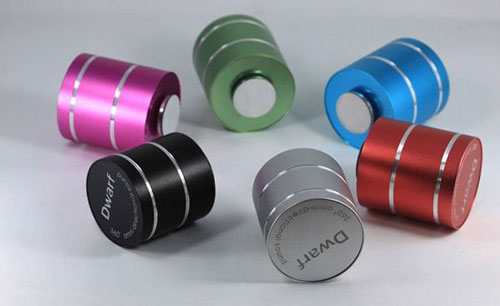
Every now and then a gadget comes along that really blows our hair back. Often it’s not even the flashiest or priciest gadgets that do it, but the ones that take us by surprise by doing something we’ve never seen before. The Mighty Dwarf “vibration multimedia speaker” is one such device.
The Mighty Dwarf turns any surface — though wooden tables seem to work best — into an impressive omnidirectional sound system. Essentially, by means of resonance and some sort of physics trickery, it turns any surface into an enormous speaker.
Though it sounds like the worst mono speaker on the cheapest mobile phone when not placed on a surface, the quality of sound the Mighty Dwarf produces on a table, countertop, or even a wooden floor, is phenomenal. Glass and marble tops work, too, but lack the rich tone wooden surfaces give.
We found wooden surfaces, particularly those with space beneath them like tables, produced by far the best results with the most impressive timbre. Other surfaces produced acceptable results, but glass only seemed to work well if there was space beneath it, and marble seemed to absorb too much of the vibration generated by the Mighty Dwarf resulting in distinctly muddy audio.

The Mighty Dwarf doesn’t just produce rich sound in terms of quality bass, mid-tones and highs, but it really does sound like it’s coming from a surround sound system with multiple satellite speakers.
There are a couple of inescapable design flaws with the Mighty Dwarf that will hopefully be rectified in future versions of the device. Though the ability to play tracks directly from a microSD card is great, with the device having only a track forward or back switch — that also doubles as a volume controller — and no visual interface whatsoever it’s very difficult to navigate a large collection of music.
Users can plug any music player with a 3,5mm socket into the Mighty Dwarf, which is fantastic, but having to do so via a proprietary 3,5mm to mini USB cable is far from ideal. Cables, like socks, have a tendency to go missing.
In addition, it’s not the more common microUSB like the sort found on most smartphones, but the mini USB of the sort found on external hard drives. A regular jack-to-jack input would be far more practical, but would also necessitate another port on the device as the mini USB is also used for charging it.
The Mighty Dwarf comes with a 4GB microSD card in tow, which is more than enough storage for a holiday playlist, and considering it’s impossible to play the card’s contents randomised or see what’s coming next, most people will probably opt to plug in a phone or digital music player most of the time anyway.
Another major problem with the Mighty Dwarf is the gel pad on the bottom of the device that is clearly integral to its operation. It’s covered by a sticker that you’re advised to reapply when the device isn’t in use and you’re almost guaranteed to lose it.
Craig Wilson checks out the Mighty Dwarf (via YouTube):
Around the gel pad is a thread that suggests the device can be screwed into something else. It turns out there’s a larger version called the Mighty Monster that has attachments at the bottom, which explains the thread found on its smaller sibling, and that boosts the volume and makes the sticker unnecessary.
The Mighty Monster also includes a regular 3,5mm jack and a protective case, making it considerably less fiddly than the Mighty Dwarf, but both less compact and more expensive. Though the Mighty Dwarf is available for R499, the larger Mighty Monster is R799.
The device is available in a range of colours, and although fairly heavy at more than 420g it’s about half the size of a soft drink can, making it perfect for travellers. The Mighty Dwarf is a truly incredible device but one that could do with a little bit of refinement before its next iteration. — Craig Wilson, TechCentral
- Subscribe to our free daily newsletter
- Follow us on Twitter or on Google+ or on Facebook
- Visit our sister website, SportsCentral (still in beta)

